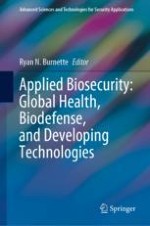2021 | OriginalPaper | Buchkapitel
Applied Biosecurity in the Face of Epidemics and Pandemics: The COVID-19 Pandemic
verfasst von : Samantha Dittrich, Lauren Richardson, Ryan N. Burnette
Erschienen in: Applied Biosecurity: Global Health, Biodefense, and Developing Technologies
Aktivieren Sie unsere intelligente Suche, um passende Fachinhalte oder Patente zu finden.
Wählen Sie Textabschnitte aus um mit Künstlicher Intelligenz passenden Patente zu finden. powered by
Markieren Sie Textabschnitte, um KI-gestützt weitere passende Inhalte zu finden. powered by
